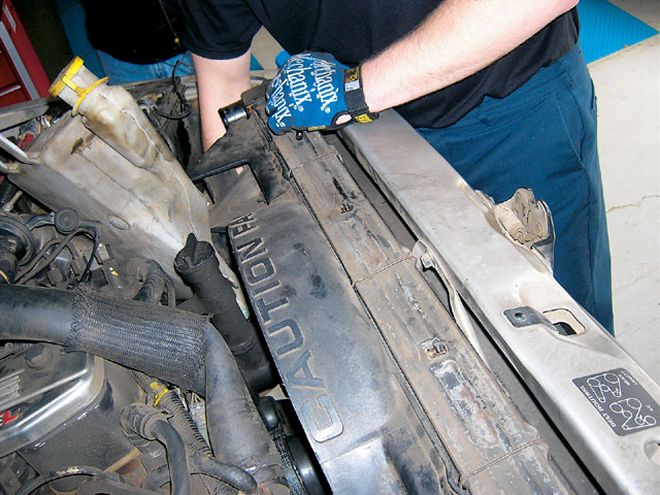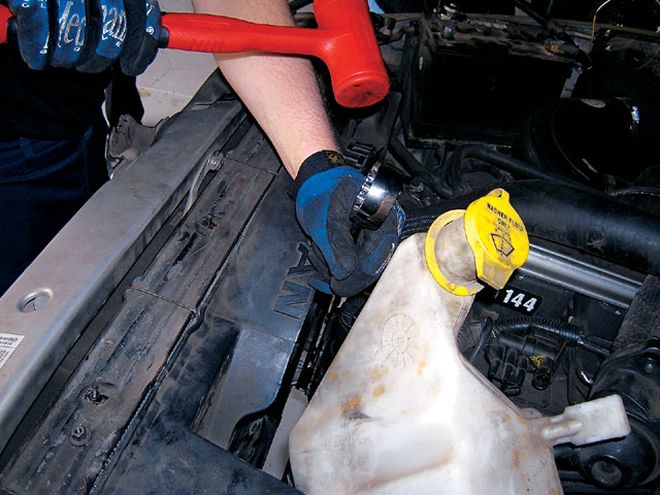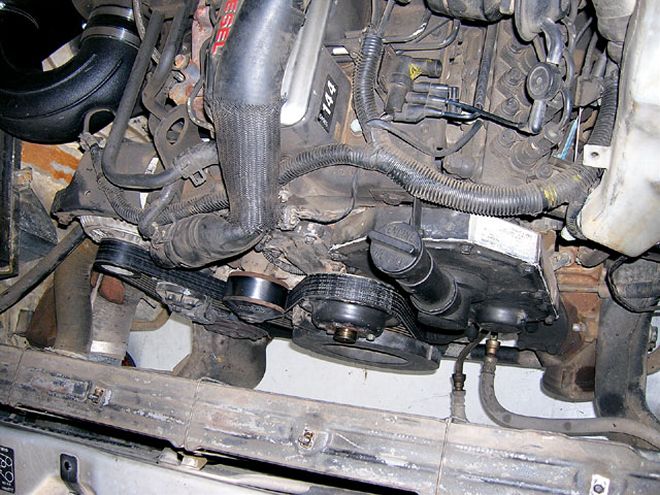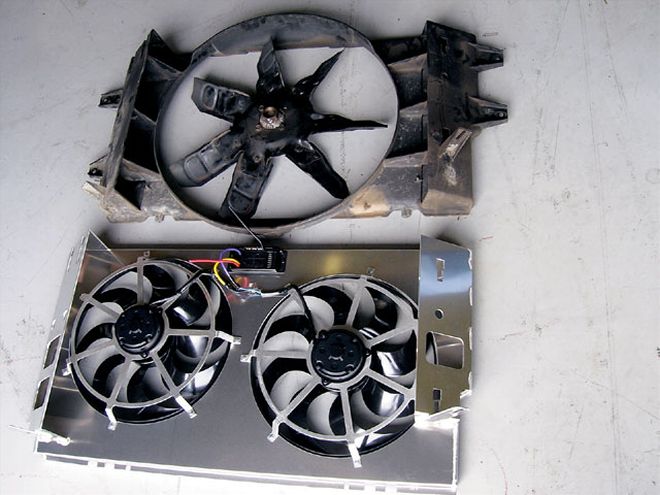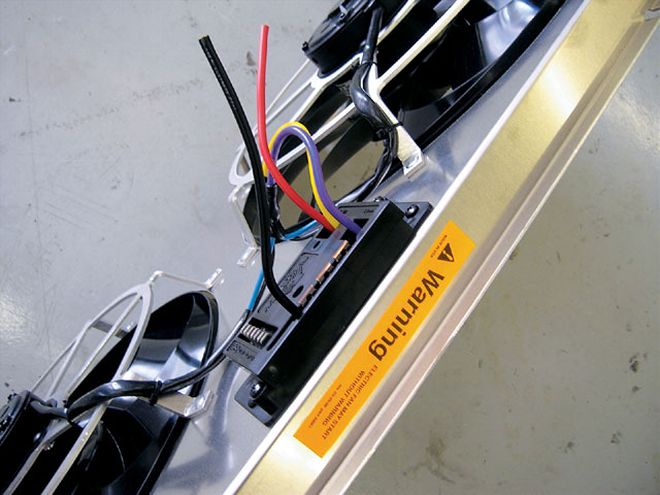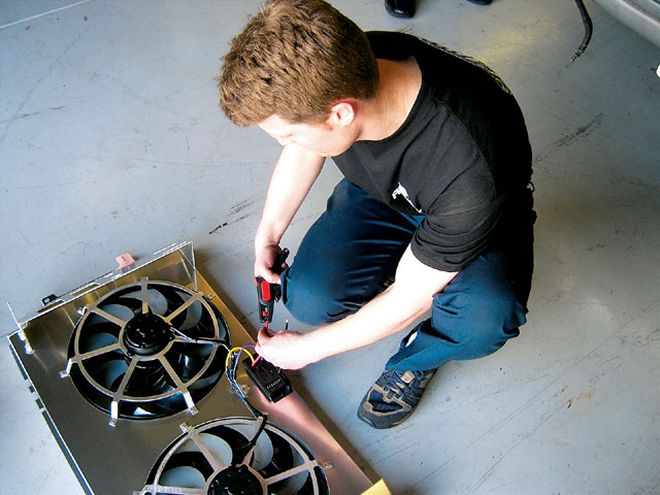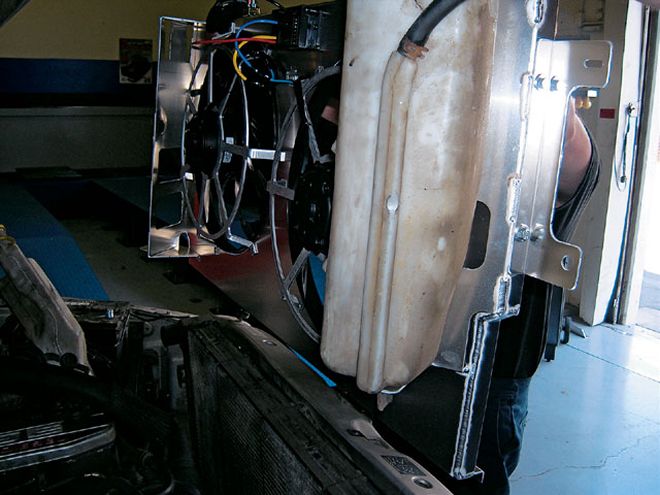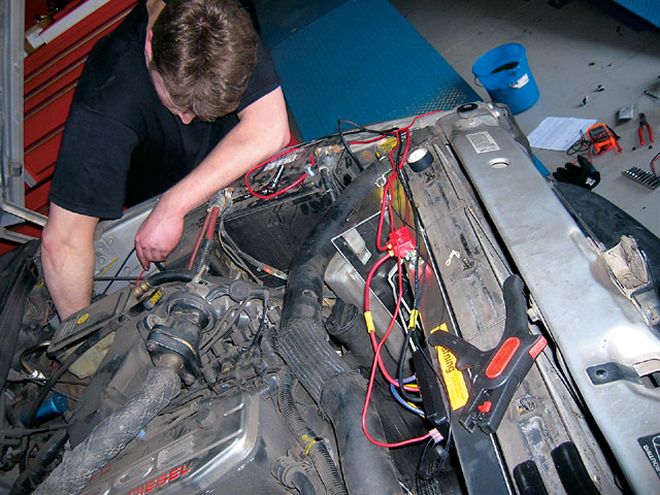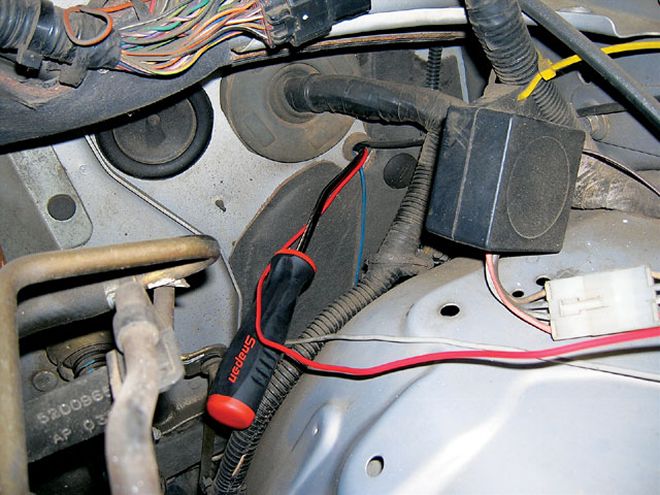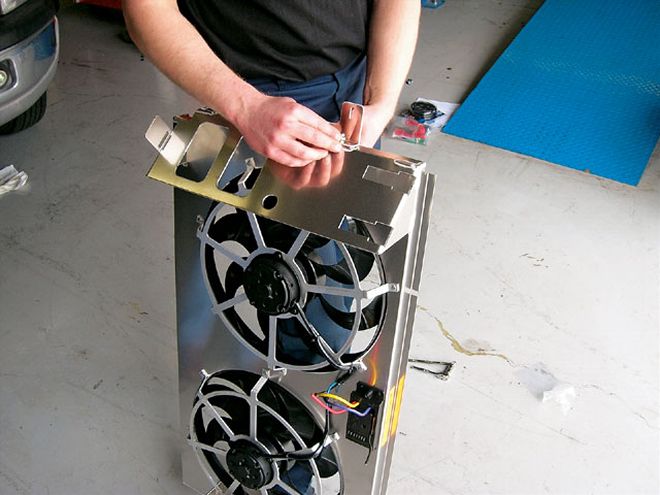
| 1997 Dodge Ram 3500 fan
Diesel engines are notoriously overbuilt-strong engine parts, strong transmissions, and big cooling systems for all that heat. One-ton truck radiators are twice the size of a normal car's, and mechanical fans (20 inches or more in diameter) are common for diesels, but there is still room for improvement. As higher-horsepower diesels spin at least 4,000 rpm, those 20-inch fans get really, really energy hungry-ultimately costing horsepower in the process. Under light-load conditions, such as freeway driving, a great deal of airflow from the fan may not be needed, but the fan will turn anyway (which translates to higher costs at the pump). Finally, there are certain instances, like when towing, where you will be under a high load, low engine speed, and the mechanical fan will be working as hard as it can and still might not move enough air to keep the engine cool.
To combat these limitations, Flex-a-lite has introduced a line of electric fans and shrouds for Chevy, Dodge, and Ford diesels. These fan kits come as a combination of two fans, a programmer, and a shroud; wiring and instructions are also included. Electric fans can provide maximum airflow for cooling whenever it's necessary (even close to idle), they don't rob horsepower at high engine speeds, and they can be adjusted to activate at various temperatures. Flex-a-lite has reported up to a 27hp increase and a 6 percent gain in fuel economy with electric fans, so to test the mileage and horsepower gains, we got a set of electric fans for our '97 Dodge Ram 3500. The installation was fairly straightforward, with the wiring being the only slightly difficult part.
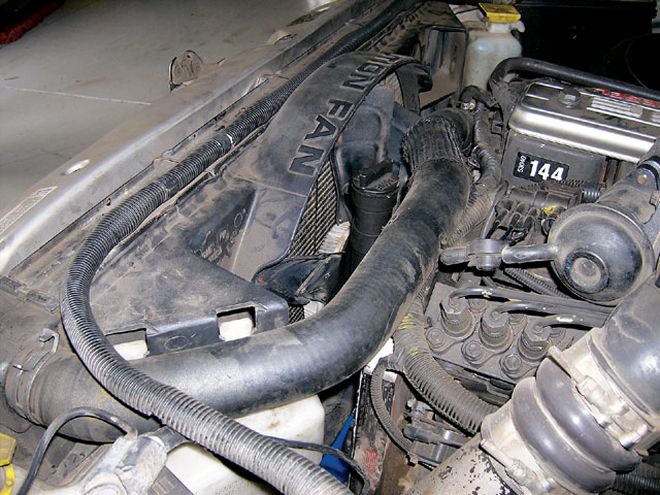
| This is the stock fan and shroud-nothing fancy, but it's functional. The radiator is so large on the Cummins that not much airflow is needed, but for performance or racing, electric fans can be a definite improvement.
After the fans were installed, we immediately floored it to see if we could feel a horsepower increase, but let's face it, a few more horsepower in a 180hp, 7,000-pound truck won't throw you back in the seat. One thing we did notice was that the engine temps quickly stabilized when the fans came on, showing that their airflow capacity was more than suitable. Also, part-throttle acceleration seemed to improve, leading us to believe that the engine was able to use more of the power it made at part-throttle instead of using it to turn fan blades. One of the biggest differences came in fuel economy. Before, the Dodge Ram averaged about 21 mpg on the highway, and now it's averaging 23-24 mpg-a noticeable improvement.
In the end, we found Flex-a-lite's claims of more power and better fuel economy to be right on the mark, with the fuel-economy numbers being even better than we expected. Also, despite repeated attempts to overheat the truck by blasting up hills, we never succeeded.
 | 1997 Dodge Ram 3500 fan
Diesel engines are notoriously overbuilt-strong engine parts, strong transmissions, and big cooling systems for all that heat. One-ton truck radiators are twice the size of a normal car's, and mechanical fans (20 inches or more in diameter) are common for diesels, but there is still room for improvement. As higher-horsepower diesels spin at least 4,000 rpm, those 20-inch fans get really, really energy hungry-ultimately costing horsepower in the process. Under light-load conditions, such as freeway driving, a great deal of airflow from the fan may not be needed, but the fan will turn anyway (which translates to higher costs at the pump). Finally, there are certain instances, like when towing, where you will be under a high load, low engine speed, and the mechanical fan will be working as hard as it can and still might not move enough air to keep the engine cool.
To combat these limitations, Flex-a-lite has introduced a line of electric fans and shrouds for Chevy, Dodge, and Ford diesels. These fan kits come as a combination of two fans, a programmer, and a shroud; wiring and instructions are also included. Electric fans can provide maximum airflow for cooling whenever it's necessary (even close to idle), they don't rob horsepower at high engine speeds, and they can be adjusted to activate at various temperatures. Flex-a-lite has reported up to a 27hp increase and a 6 percent gain in fuel economy with electric fans, so to test the mileage and horsepower gains, we got a set of electric fans for our '97 Dodge Ram 3500. The installation was fairly straightforward, with the wiring being the only slightly difficult part.
| 1997 Dodge Ram 3500 fan
Diesel engines are notoriously overbuilt-strong engine parts, strong transmissions, and big cooling systems for all that heat. One-ton truck radiators are twice the size of a normal car's, and mechanical fans (20 inches or more in diameter) are common for diesels, but there is still room for improvement. As higher-horsepower diesels spin at least 4,000 rpm, those 20-inch fans get really, really energy hungry-ultimately costing horsepower in the process. Under light-load conditions, such as freeway driving, a great deal of airflow from the fan may not be needed, but the fan will turn anyway (which translates to higher costs at the pump). Finally, there are certain instances, like when towing, where you will be under a high load, low engine speed, and the mechanical fan will be working as hard as it can and still might not move enough air to keep the engine cool.
To combat these limitations, Flex-a-lite has introduced a line of electric fans and shrouds for Chevy, Dodge, and Ford diesels. These fan kits come as a combination of two fans, a programmer, and a shroud; wiring and instructions are also included. Electric fans can provide maximum airflow for cooling whenever it's necessary (even close to idle), they don't rob horsepower at high engine speeds, and they can be adjusted to activate at various temperatures. Flex-a-lite has reported up to a 27hp increase and a 6 percent gain in fuel economy with electric fans, so to test the mileage and horsepower gains, we got a set of electric fans for our '97 Dodge Ram 3500. The installation was fairly straightforward, with the wiring being the only slightly difficult part.
 | This is the stock fan and shroud-nothing fancy, but it's functional. The radiator is so large on the Cummins that not much airflow is needed, but for performance or racing, electric fans can be a definite improvement.
After the fans were installed, we immediately floored it to see if we could feel a horsepower increase, but let's face it, a few more horsepower in a 180hp, 7,000-pound truck won't throw you back in the seat. One thing we did notice was that the engine temps quickly stabilized when the fans came on, showing that their airflow capacity was more than suitable. Also, part-throttle acceleration seemed to improve, leading us to believe that the engine was able to use more of the power it made at part-throttle instead of using it to turn fan blades. One of the biggest differences came in fuel economy. Before, the Dodge Ram averaged about 21 mpg on the highway, and now it's averaging 23-24 mpg-a noticeable improvement.
In the end, we found Flex-a-lite's claims of more power and better fuel economy to be right on the mark, with the fuel-economy numbers being even better than we expected. Also, despite repeated attempts to overheat the truck by blasting up hills, we never succeeded.
| This is the stock fan and shroud-nothing fancy, but it's functional. The radiator is so large on the Cummins that not much airflow is needed, but for performance or racing, electric fans can be a definite improvement.
After the fans were installed, we immediately floored it to see if we could feel a horsepower increase, but let's face it, a few more horsepower in a 180hp, 7,000-pound truck won't throw you back in the seat. One thing we did notice was that the engine temps quickly stabilized when the fans came on, showing that their airflow capacity was more than suitable. Also, part-throttle acceleration seemed to improve, leading us to believe that the engine was able to use more of the power it made at part-throttle instead of using it to turn fan blades. One of the biggest differences came in fuel economy. Before, the Dodge Ram averaged about 21 mpg on the highway, and now it's averaging 23-24 mpg-a noticeable improvement.
In the end, we found Flex-a-lite's claims of more power and better fuel economy to be right on the mark, with the fuel-economy numbers being even better than we expected. Also, despite repeated attempts to overheat the truck by blasting up hills, we never succeeded.
